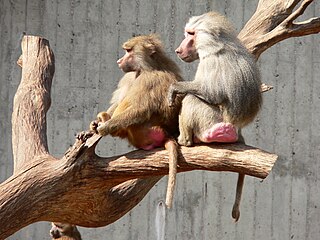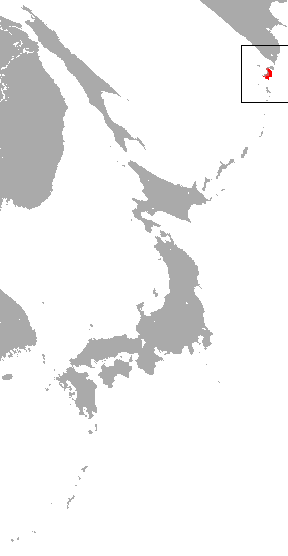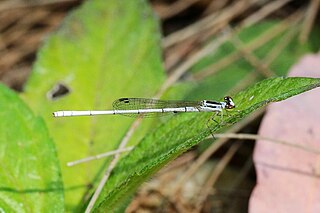
The hamadryas baboon is a species of baboon within the Old World monkey family. It is the northernmost of all the baboons, being native to the Horn of Africa and the southwestern region of the Arabian Peninsula. These regions provide habitats with the advantage for this species of fewer natural predators than central or southern Africa where other baboons reside. The hamadryas baboon was a sacred animal to the ancient Egyptians and appears in various roles in ancient Egyptian religion, hence its alternative name of 'sacred baboon'.

The Guinea baboon is a baboon from the Old World monkey family. Some (older) classifications list only two species in the genus Papio, this one and the hamadryas baboon. In those classifications, all other Papio species are considered subspecies of P. papio and the species is called the savanna baboon.

A harem is an animal group consisting of one or two males, a number of females, and their offspring. The dominant male drives off other males and maintains the unity of the group. If present, the second male is subservient to the dominant male. As juvenile males grow, they leave the group and roam as solitary individuals or join bachelor herds. Females in the group may be inter-related. The dominant male mates with the females as they become sexually active and drives off competitors, until he is displaced by another male. In some species, incoming males that achieve dominant status may commit infanticide.

Dichondra is a small genus of flowering plants in the morning glory family, Convolvulaceae. They are prostrate, perennial, herbaceous plants, with creeping stems which take root readily at the leaf nodes. The flowers are white, greenish or yellowish, 2–3 mm diameter. Members of the genus are commonly known as ponysfoots and are native to tropical and cool temperate regions around the world.

Cracker butterflies are a Neotropical group of medium-sized brush-footed butterfly species of the genus Hamadryas. They acquired their common name due to the unusual way that males produce a "cracking" sound as part of their territorial displays. The most comprehensive work about their ecology and behavior is that of Julian Monge Najera et al. (1998). The genus was erected by Jacob Hübner in 1806.
Albula virgata is a species of marine fish found in the Hawaiian Islands. It is known commonly as the longjaw bonefish. They grow up to 32 cm (13 in).
The Kungwe apalis is a species in the family Cisticolidae. It was previously considered it to be a subspecies of the buff-throated apalis. It is found in Burundi, Democratic Republic of the Congo, Rwanda, and Tanzania.

The Paramushir shrew is a species of mammal in the family Soricidae. It is endemic to Russia. Its natural habitat is temperate forests. It is likely named for Paramushir Island, home to several other species of shrew in the genus Sorex.

Aglaia argentea is a species of plant in the family Meliaceae. It is a tree found in Australia, Brunei, India, Indonesia, Malaysia, Myanmar, Papua New Guinea, the Philippines, the Solomon Islands, and Thailand.

Heliotropium arboreum is a species of flowering plant in the borage family, Boraginaceae. It is native to tropical Asia including southern China, Madagascar, northern Australia, and most of the atolls and high islands of Micronesia and Polynesia. Common names include velvetleaf soldierbush, tree heliotrope, veloutier, and octopus bush. It is a shrub or small tree typical of littoral zones reaching a height of 3.6 m (12 ft), with a spread of about 5 m (16 ft).

Baboons are primates comprising the genus Papio, one of the 23 genera of Old World monkeys, in the family Cercopithecidae. There are six species of baboon: the hamadryas baboon, the Guinea baboon, the olive baboon, the yellow baboon, the Kinda baboon and the chacma baboon. Each species is native to one of six areas of Africa and the hamadryas baboon is also native to part of the Arabian Peninsula. Baboons are among the largest non-hominoid primates and have existed for at least two million years.

Sphyraena argentea is a predatory fish found in the northeast Pacific Ocean. They range from Cabo San Lucas, Baja California to Washington. However, they are not common north of Point Conception in Santa Barbara County, California. They can reach a length of about 1.2 metres (3.9 ft) and a weight of about 6.8 kilograms (15 lb). California barracuda are very popular sport fish in Southern California.

Albula is an ancient genus of fish belonging to the family Albulidae. Members of this genus inhabit warm coastal waters worldwide.

Polyommatus (Agrodiaetus) violetae, the Andalusian anomalous blue, is a species of butterfly in the family Lycaenidae. It is found in the south and south-east of Spain. Adults are on wing from July to August.
Hamadryas is a genus of flowering, perennial herbs in the family Ranunculaceae. It is found in the southernmost regions of Chile and Argentina, as well as the Falkland Islands, predominantly in alpine and sub-alpine habitats. The range of one species, Hamadryas delfinii, extends north into San Juan Province, Argentina.
Albula argentea, the silver sharpjaw bonefish, is a species of marine fish found in the tropical western Pacific Ocean. They grow up to 70 cm (28 in).

Agriocnemis argentea is a species of damselfly in the family Coenagrionidae, commonly known as a silver wisp. It is a small damselfly; the male, when mature, is covered in a white pruinescence. It is endemic to northern Australia where it inhabits both still and flowing waters.
Albula oligolepis is a species of marine fish found in the Indo-West Pacific. It is known commonly as the smallscale bonefish. They grow up to 32 cm (13 in).














